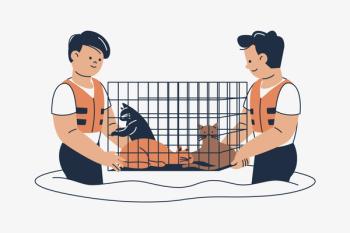Mixing the perfect cocktail
Without further ado, here's how to mix a Storm Sangria:
1. Screen for the level of panic using a storm fear scorecard.
In my general practice, I found it helpful to use this storm report card to screen patients for their level of fear. This tool allowed me to quickly provide the medication or supplement needed and implement a simple safety plan to reduce storm fear.
2. Determine the medication plan.
This is based on the fear-screening score:
- Levels 2 to 4: Adaptil collar worn 24/7. The Adaptil pheromone collar provides calming at any time of the day or night, which helps prevent fear escalation, especially when a surprise storm or noise pops up.
- Levels 3 and 4: Propranolol at 5 mg/15 kg up to 20 mg maximum. Propranolol decreases the physical signs of increasing anxiety, which helps a dog move to the safe room.
- Level 4: Diazepam at 2 to 5 mg/dog. Diazepam provides mild sedation and anxiety reduction for dogs that would injure themselves in escape attempts.
There are other medications that can work well, so the Storm Sangria is customizable based on your preferences. But the ease of administration, duration of action and reduction of physical signs to aid in getting to the safe room are why I kept most of my patients on this specific cocktail.
3. Teach the dog to happily hang out in a safe room.
This can be a bathroom, basement or closet. Clients can teach their dog to go to the bathroom or basement readily by using the “learn to earn” game. They'll reward the dog as it approaches the bathroom or basement, then quickly toss food in the room to make it fun to stay in there. I have a video on my YouTube channel, “Get in the Bathroom,” that demonstrates this process.
4. Place a frozen Kong food puzzle in the safe room.
A frozen food puzzle lasts for hours. Clients can have these ready by stocking the freezer with a few ahead of time. When it's time to set up the safe room, they toss in the Kong and they're all set.
5. Play music that's heavy on the bass.
I've found that rhythmic rock works best. In my personal and clinical experience, the heavy beat of rock music calms dogs better than classical. I've asked clients to tell me what specific songs helped their dogs be calm, and my own dog Butterscotch liked North African drumming music. From this client input I created the Butterscotch playlist. Use this list to help your clients create their own calming safe-room music list.
A note about older dogs
Geriatric dogs can be worse or better with storms. For dogs over 10 that experience storm fear, mix a Senior Storm Sangria. This cocktail consists of an Adaptil collar worn 24/7 as well as a daily milk protein supplement (Zylkene-Vetoquinol), omega-3 fatty acid supplement and nonsteroidal anti-inflammatory drug of choice for reducing any arthritis pain. Then implement the safe-room plan, the music and a food puzzle. Often, other sedating and anxiety-reducing medications are not needed when addressing age-related health problems, although a carpet runner may be needed to help the older dog walk to the safe room.
Last call
Storm and noise fears can seriously affect both the dog and the owner. Sleepless nights, damage to home and expensive veterinary bills can break the bond with a pet. Prevent problems by advising all dog owners to create a safe room for their pets and send them there during storms or other noisy events. This intervention plan provides a sense of calm and safety-something both noise-phobic dogs and their owners will appreciate.
References
- Houpt K. Managing noise fears and phobias. American Veterinarian 2018;3(8):28-29.
- Horwitz D, ed. Blackwell's five-minute veterinary consult clinical companion: Canine and feline behavior. 2nd ed. Hoboken, New Jersey: Wiley Blackwell, 2018:375-387.
- Landsburg G, Hunthausen W, Ackerman L. Handbook of behavior problems of the dog and cat. New York: Elselvier, 1997:286.
Dr. Sally J. Foote is a certified animal behavior consultant with expertise in Low Stress Handling. She has practiced in general medicine for over 30 years, including ownership of Okaw Veterinary Clinic in Tuscola, Illinois, one of the first Low Stress Handling Certified Clinics in the United States, where she developed a medical record system for recording the positive reinforcers for the veterinary exam. Dr. Foote is also past president of the American Veterinary Society of Animal Behavior and executive director of Cattle Dog Publishing, the legacy of Dr. Sophia Yin.







